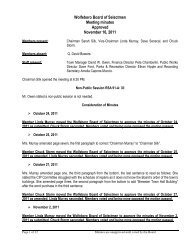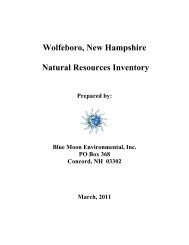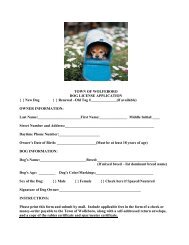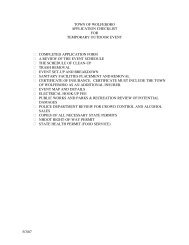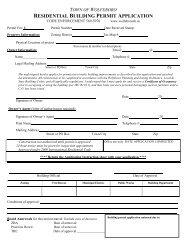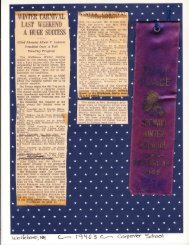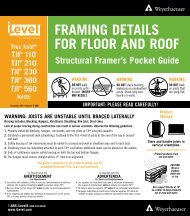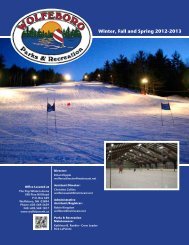Natural Resources Chapter of the Master Plan - Town of Wolfeboro
Natural Resources Chapter of the Master Plan - Town of Wolfeboro
Natural Resources Chapter of the Master Plan - Town of Wolfeboro
You also want an ePaper? Increase the reach of your titles
YUMPU automatically turns print PDFs into web optimized ePapers that Google loves.
<strong>Natural</strong> <strong>Resources</strong> <strong>Chapter</strong>, <strong>Wolfeboro</strong>, NH<br />
13.3 ANALYSIS OF TOOLS FOR WETLAND PROTECTION<br />
Activities in wetlands are regulated by <strong>the</strong> NH Department <strong>of</strong> Environmental Services (NHDES<br />
– Wetlands Bureau) and <strong>the</strong> US Army Corps <strong>of</strong> Engineers (USACE). In New Hampshire, towns<br />
are allowed to develop more restrictive regulations to manage important resources within <strong>the</strong>ir<br />
town.<br />
Article II <strong>of</strong> section §175 <strong>of</strong> <strong>the</strong> <strong>Wolfeboro</strong> <strong>Town</strong> Zoning Ordinances establishes a Wetlands<br />
Conservation Overlay District, which regulates land use surrounding naturally occurring<br />
wetlands. The Wetlands Conservation Overlay District:<br />
<br />
<br />
<br />
<br />
<br />
Prevents development, destruction, and significant changes to naturally occurring<br />
wetlands;<br />
Protects rare, unique and unusual natural species and <strong>the</strong>ir habitats;<br />
Maintains ecological balances;<br />
Protects existing and potential water supplies, aquifers, and aquifer recharge areas;<br />
Protects <strong>the</strong> wetlands, watercourses and water bodies <strong>of</strong> <strong>the</strong> <strong>Town</strong> from degradation and<br />
helps maintain <strong>the</strong>ir natural beauty.<br />
For permitted land uses, <strong>the</strong> Wetlands Conservation Overlay District emphasizes <strong>the</strong> importance<br />
<strong>of</strong> using best management practices in order to protect wetlands. A list <strong>of</strong> permitted practices can<br />
be found in <strong>the</strong> Zoning Ordinance. The ordinance regulates <strong>the</strong>se permitted land uses; including:<br />
<br />
For a permitted land use, it is prohibited to alter <strong>the</strong> natural surface configuration <strong>of</strong> a<br />
prime wetland by <strong>the</strong> addition <strong>of</strong> fill or by dredging. For wetlands, <strong>the</strong> fill or dredging <strong>of</strong><br />
1,000 square feet or more is also prohibited.<br />
For a permitted land use, forestry/tree farming is limited to <strong>the</strong> removal <strong>of</strong> less than 50<br />
percent <strong>of</strong> <strong>the</strong> basal area <strong>of</strong> <strong>the</strong> standing timber in any ten-year period. This guarantees a<br />
well-distributed stand <strong>of</strong> healthy, growing trees.<br />
<br />
For a permitted land use, protection <strong>of</strong> <strong>the</strong> wetland from any form <strong>of</strong> pollution is highly<br />
emphasized.<br />
Most land use practices require a special use permit. Practices that require special use permits<br />
are also listed in <strong>the</strong> Zoning Ordinance. Special use permits allow regulated land uses to be<br />
practiced near a protected wetland, as described below:<br />
No building activity is permitted within 50 feet <strong>of</strong> any poorly drained soil and within 75<br />
feet <strong>of</strong> any very poorly drained soil, except if provided in a special use permit.<br />
<strong>Natural</strong> <strong>Resources</strong> Inventory, <strong>Wolfeboro</strong>, NH 64



